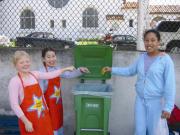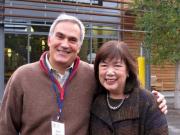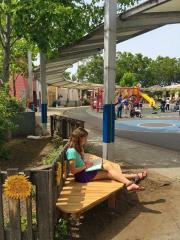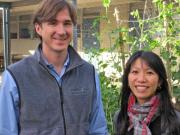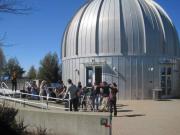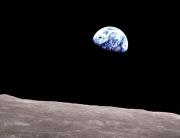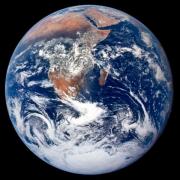Informal Environmental Education
In my study of the K-12 environmental education movement this year, it has become clear that the partnership between schools and the "informal" network of museums, aquariums, and outdoor programs is vital to the vibrancy of our overall educational effort. Here are reports on two of Northern California's most impressive science centers, the Chabot Space and Science Center and the California Academy of Sciences.
1. Chabot Space and Science Center: The “Go To” Place for Earth and Space
When I learned in 2000 that the Chabot Space & Science Center (CSSC) was opening a new, 86,000 square foot, $80 million, state-of-the-art science education center in the Oakland hills, I was delighted.  Located just three miles from Head-Royce School where I was the school head, CSSC promised to offer students and teachers from all over Northern California an exciting venue where they could become inspired about science education. Visiting Chabot again recently, it was wonderful to see their original vision flourishing as they attract 164,000 visitors, including 50,000 K-12 students, annually to this place where “informal science education” is teaching about the challenges of climate change and the vital need for environmental education.
Located just three miles from Head-Royce School where I was the school head, CSSC promised to offer students and teachers from all over Northern California an exciting venue where they could become inspired about science education. Visiting Chabot again recently, it was wonderful to see their original vision flourishing as they attract 164,000 visitors, including 50,000 K-12 students, annually to this place where “informal science education” is teaching about the challenges of climate change and the vital need for environmental education.
Since his arrival at Chabot, Executive Director Alex Zwissler has brought a vision of the critical role CSSC can play in science education.  Born in Germany and raised in Oakland, he recalls joining his elementary school’s Rocket Club and then participating in an accelerated partnership program in physics and chemistry between Redwood Heights Elementary School and UC Berkeley’s Lawrence Hall of Science, where he later received his undergraduate degree in political science. Under his leadership and with the encouragement of the Board, Chabot has taken a strong position on the challenge of climate change and the need for our science programs to inspire solutions. Writing in the Center’s winter newsletter about the launch of Bill Nye’s Climate Lab, he described how the facility gives visitors a chance to learn about the science of climate change and discover ways to change their behavior to make a difference. I observed dozens of youth excitedly exploring how to generate electricity from turbines and how biking can reduce greenhouse gases. Addressing those who question the advocacy position the Center has taken, he notes that all exhibits are based on evidence that has been developed by a “community of qualified peers in their respective fields of science” and that “our position on climate change is that we accept the peer reviewed science to date.”
Born in Germany and raised in Oakland, he recalls joining his elementary school’s Rocket Club and then participating in an accelerated partnership program in physics and chemistry between Redwood Heights Elementary School and UC Berkeley’s Lawrence Hall of Science, where he later received his undergraduate degree in political science. Under his leadership and with the encouragement of the Board, Chabot has taken a strong position on the challenge of climate change and the need for our science programs to inspire solutions. Writing in the Center’s winter newsletter about the launch of Bill Nye’s Climate Lab, he described how the facility gives visitors a chance to learn about the science of climate change and discover ways to change their behavior to make a difference. I observed dozens of youth excitedly exploring how to generate electricity from turbines and how biking can reduce greenhouse gases. Addressing those who question the advocacy position the Center has taken, he notes that all exhibits are based on evidence that has been developed by a “community of qualified peers in their respective fields of science” and that “our position on climate change is that we accept the peer reviewed science to date.”
Strolling the facility with Alex, it was evident that the Center is engaging students well in science education, through the Challenger Learning Center that simulates space shuttle missions, the planetarium, several large telescopes, a scale model of the Mercury space capsule, and spacious labs for more formal science teaching.  It was especially exciting to see the plans for the new $3 million Redwood Environmental Education Center that will enable youth from the inner city and elsewhere to experience nature’s beauty in the heart of a large metropolis.
It was especially exciting to see the plans for the new $3 million Redwood Environmental Education Center that will enable youth from the inner city and elsewhere to experience nature’s beauty in the heart of a large metropolis.
To learn more about the Center’s role in “informal” science education, I spoke at length with Etta Heber, Director of Education and a long-time colleague, whose son Yaeir helped as Head-Royce student body president to lead the effort to green the school and who is just graduating from Swarthmore before embarking on a career in sustainability.
After a career in formal education in Oakland as a teacher, program manager and administrator, Etta joined Chabot almost twenty years ago and has built impressive professional development and education programs, recruiting Head-Royce faculty along the way to help run the Climate Change Institute for high school teachers. She believes there is a growing body of evidence that informal science education is vital to inspiring young learners.  She cites the current study sponsored by the Lawrence Hall of Science, UC Berkeley and Inverness Research that is evaluating the question, “how can we activate children’s interest and curious minds in ways that ignite persistent engagement in science learning and critical inquiry.” Learning Science in Informal Environments: People, Places, and Pursuits, edited by Philip Bell, et al. and sponsored by the National Research Council (2009), concludes that “there is mounting evidence that structured, non-school science programs can feed or stimulate the science-specific interests of adults and children, may positively influence academic achievement for students, and may expand participants’ sense of future science career options.” (pg. 3) And a just-released study of the California Science Center in Los Angeles by Oregon State University’s Science Center presents research data that “confirms the enormous value of science museums, ‘free-choice’ learning.” (OSU, 4-7-11)
She cites the current study sponsored by the Lawrence Hall of Science, UC Berkeley and Inverness Research that is evaluating the question, “how can we activate children’s interest and curious minds in ways that ignite persistent engagement in science learning and critical inquiry.” Learning Science in Informal Environments: People, Places, and Pursuits, edited by Philip Bell, et al. and sponsored by the National Research Council (2009), concludes that “there is mounting evidence that structured, non-school science programs can feed or stimulate the science-specific interests of adults and children, may positively influence academic achievement for students, and may expand participants’ sense of future science career options.” (pg. 3) And a just-released study of the California Science Center in Los Angeles by Oregon State University’s Science Center presents research data that “confirms the enormous value of science museums, ‘free-choice’ learning.” (OSU, 4-7-11)
Last summer Etta Heber invited me to hear a lecture at Chabot by James Hansen, Columbia University professor and director of the NASA Goddard Institute for Space Studies on his new book Storms of My Grandchildren: The Truth About the Coming Climate Catastrophe and Our Last Chance to Save Humanity (2010). Hansen played a key role in the 1980s alerting Congress and the public to the phenomenon of global warming. His talk was just one example of how Chabot Space & Science Center is leading the way in science and environmental education. With its bold new strategic plan that seeks to position the Center as “The ‘go to’ place for earth and space,” Chabot Space & Science Center is helping forge the path for strengthening educational programs for our youth.
2. California Academy of Sciences: Leading “Informal” Science Education
When I first lived in San Francisco and was teaching at University High School, the California Academy of Sciences was a big part of my family’s life. Often my wife Helen and I would stroll through our neighborhood to Golden Gate Park and visit the Academy with our two young boys. They loved this living museum, as they stood in awe next to prehistoric dinosaurs and watched the  circling fish in the aquarium. As a teacher I enjoyed watching my students gain a passion for science through special programs, like young Eames Demetrios who journeyed on an Academy-sponsored trip to study whale sharks in the South Pacific. Some years later as a dad it was wonderful to see the transformation in my son Peter when he as a middle school student joined his grandmother an Academy trip to East Africa; this experience in part inspired his career working in Africa on justice-for-the-poor initiatives with the Carter Center and the World Bank. So I can say from firsthand experience that “informal” science and environmental education can have a big impact on young minds.
circling fish in the aquarium. As a teacher I enjoyed watching my students gain a passion for science through special programs, like young Eames Demetrios who journeyed on an Academy-sponsored trip to study whale sharks in the South Pacific. Some years later as a dad it was wonderful to see the transformation in my son Peter when he as a middle school student joined his grandmother an Academy trip to East Africa; this experience in part inspired his career working in Africa on justice-for-the-poor initiatives with the Carter Center and the World Bank. So I can say from firsthand experience that “informal” science and environmental education can have a big impact on young minds.
It was a treat to return to the Academy this spring to see the new, fabulously rebuilt facilities, the world’s largest LEED platinum museum. Meeting with Chris Andrews, Chief Operations Officer and Director of the Steinhart Aquarium, gave me a real appreciation for the role the Academy is playing in improving the quality of K-12 science education and in taking a leadership position on addressing the challenges of climate change.  Andrews himself has a long history of engagement with environmental issues. Raised in England, he early on was excited about nature, which prompted him to earn his B.S. in zoology and eventually receive a Ph.D. in fish diseases. Through his work at the Department of Natural Resources in England, the London Zoo, the National Aquarium in Baltimore, and the South Carolina Aquarium, he became increasingly concerned about the plight of the rainforests and coral reefs and decided to do something about it. Since he joined the California Academy of Sciences six years ago, he has been working to incorporate sustainable practices.
Andrews himself has a long history of engagement with environmental issues. Raised in England, he early on was excited about nature, which prompted him to earn his B.S. in zoology and eventually receive a Ph.D. in fish diseases. Through his work at the Department of Natural Resources in England, the London Zoo, the National Aquarium in Baltimore, and the South Carolina Aquarium, he became increasingly concerned about the plight of the rainforests and coral reefs and decided to do something about it. Since he joined the California Academy of Sciences six years ago, he has been working to incorporate sustainable practices.
The new building itself is an example for Andrews of “walking the walk” of environmental sustainability. The largest public LEED platinum rated building in the world, it is also the “greenest museum.”  Many energy-saving and sustainable features were incorporated including natural light and ventilation, a 213,000 kW solar system with 60,000 panels, 50% of the lumber from sustainable-yield forests, and 95% of the steel from recycled sources. And in its operation, the exhibits currently include a large presentation on “Altered State: Climate Change in California” and a handy “Green Guide: Sustainability Made Simple.”
Many energy-saving and sustainable features were incorporated including natural light and ventilation, a 213,000 kW solar system with 60,000 panels, 50% of the lumber from sustainable-yield forests, and 95% of the steel from recycled sources. And in its operation, the exhibits currently include a large presentation on “Altered State: Climate Change in California” and a handy “Green Guide: Sustainability Made Simple.”
Perhaps the “coolest” feature of the new Academy of Sciences is the green roof, 2.5 acres of undulating surface that mirrors the original hills of San Francisco that has been planted with 80 native species. Weighing 2.5 million lbs., the roof provides significant cooling to the building during the summer and retains heat in the winter, and as an example of the new urban architecture demonstrates how we can reduce the heat-island effect in our cities.  I was first introduced to the Academy’s visionary plan for a living roof by Alan Good, the consultant who helped us design our school garden at Head-Royce School, and he arranged for me to have a special tour of the green roof with Kendra Hauser. Like many a naturalist, she says that she was early-on inspired to a career in environmental education through childhood experiences hiking the coast range hills in Marin County and then through her degree in environmental studies at UC Santa Cruz. Hauser explained to me the way the Academy is using the roof as a teaching tool for kids and adults, and the network they are building among the other institutions in Northern California that have green roofs.
I was first introduced to the Academy’s visionary plan for a living roof by Alan Good, the consultant who helped us design our school garden at Head-Royce School, and he arranged for me to have a special tour of the green roof with Kendra Hauser. Like many a naturalist, she says that she was early-on inspired to a career in environmental education through childhood experiences hiking the coast range hills in Marin County and then through her degree in environmental studies at UC Santa Cruz. Hauser explained to me the way the Academy is using the roof as a teaching tool for kids and adults, and the network they are building among the other institutions in Northern California that have green roofs.
For Chris Andrews, the impressive new facilities give the California Academy of Sciences an opportunity to move beyond simply educating the public about the natural world and to help citizens develop a sense of purpose to address the challenge of climate change. The Academy offers an impressive array of programs for students ranging from field trips, classes and a high school intern program to promote careers in science. For teachers, workshops and classes enable them to stay current in their field, and a new Teacher Institute on Science and Sustainability will ensure that climate science is addressed in the K-12 curriculum in local schools.
The California Academy of Sciences is breaking new ground in promoting the “informal” science education that is essential to inspire the next generation of scientists. When combined with the formal K-12 environmental science curriculum, including the newly released science program called Education and the Environment Initiative, this partnership is helping California take a leading role in 21st science education. This partnership of “formal” and “informal” educational institutions models the right direction for our state.
